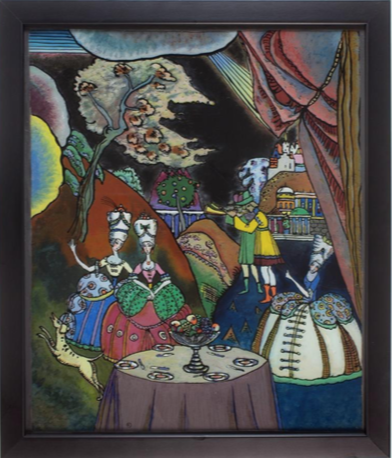Imagine owning a window into the soul of Wassily Kandinsky
This is the allure of “With Fruits,” a Hinterglasmalerei masterpiece. But consider this: painted in 1918, while Kandinsky resided in revolutionary Russia, it becomes more than just a painting. It’s a coded message, a dreamscape painted in vibrant hues against a backdrop of societal upheaval.
It’s a coded message, a dreamscape painted in vibrant hues against a backdrop of societal upheaval.
Kandinsky’s artistic journey
took a transformative turn in Murnau, Bavaria, from 1908 onwards. The partnership with Gabriele Münter, the inspiring landscapes, and the birth of Der Blaue Reiter – all contributed to his transition towards abstraction. Unfortunatly, the outbreak of World War I in 1914 forced a return to Russia, a homeland soon to be engulfed in its own revolution.
“With Fruits,” created during this tumultuous period, begs the question: Why Hinterglasmalerei, a Bavarian folk tradition, amidst the chaos of revolution? Look closely at the painting itself (as seen in the image). A laden table with a fruit bowl anchors the foreground, a symbol of abundance perhaps? Behind it, figures in elaborate 18th-century attire populate a theatrical scene. A trumpeter heralds, a leaping deer bounds, and whimsical buildings dot the landscape under a sky bursting with radiating color – all framed by a suggestive red curtain.
The Hinterglasmalerei itself,
with its folk origins, suggests nostalgia, a longing for a simpler, more ordered past. But, the deliberate theatricality, the stage-like setting, hints at something more. Is it a commentary on the grand performance of history, or a personal longing for the artistic community and creative freedom he experienced in Murnau?
Being in Russia in 1918, with Constructivism gaining ground, the ornamental nature of this Hinterglasmalerei suggests it was deeply personal, perhaps a form of resistance to the utilitarian aesthetic becoming dominant in Russia. Could it be that “With Fruits” encapsulates a yearning for artistic expression untouched by the demands of revolution? Or could it be that he used his recollection of the German aesthetic because he had no access to those materials in Russia?
Imagine owning a Wassily Kandinsky, work, “With Fruits” transcends mere possession; it is about owning a piece of history. Every detail invites contemplation. Nevertheless, the price you pay is not just for pigments and glass, but for access to Kandinsky’s artistic spirit, frozen forever on the canvas of time. By purchasing this art, you preserve a moment of reverie, a testament to memory, art, and hope in the darkest of times.

